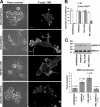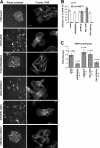uPAR-induced cell adhesion and migration: vitronectin provides the key
- PMID: 17548516
- PMCID: PMC2064291
- DOI: 10.1083/jcb.200612058
uPAR-induced cell adhesion and migration: vitronectin provides the key
Abstract
Expression of the membrane receptor uPAR induces profound changes in cell morphology and migration, and its expression correlates with the malignant phenotype of cancers. To identify the molecular interactions essential for uPAR function in these processes, we carried out a complete functional alanine scan of uPAR in HEK293 cells. Of the 255 mutant receptors characterized, 34 failed to induce changes in cell morphology. Remarkably, the molecular defect of all of these mutants was a specific reduction in integrin-independent cell binding to vitronectin. A membrane-tethered plasminogen activator inhibitor-1, which has the same binding site in vitronectin as uPAR, replicated uPAR-induced changes. A direct uPAR-vitronectin interaction is thus both required and sufficient to initiate downstream changes in cell morphology, migration, and signal transduction. Collectively these data demonstrate a novel mechanism by which a cell adhesion molecule lacking inherent signaling capability evokes complex cellular responses by modulating the contact between the cell and the matrix without the requirement for direct lateral protein-protein interactions.
Figures






References
-
- Blasi, F., and P. Carmeliet. 2002. uPAR: a versatile signalling orchestrator. Nat. Rev. Mol. Cell Biol. 3:932–943. - PubMed
-
- Chaurasia, P., J.A. Aguirre-Ghiso, O.D. Liang, H. Gardsvoll, M. Ploug, and L. Ossowski. 2006. A region in urokinase plasminogen receptor domain III controlling a functional association with alpha5beta1 integrin and tumor growth. J. Biol. Chem. 281:14852–14863. - PubMed
Publication types
MeSH terms
Substances
LinkOut - more resources
Full Text Sources
Other Literature Sources
Medical

